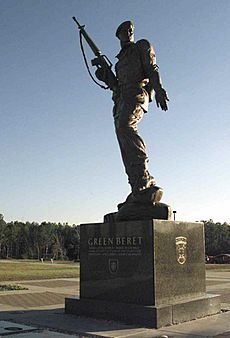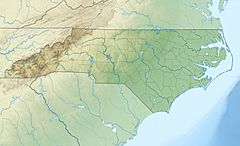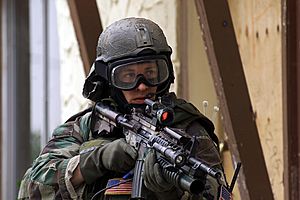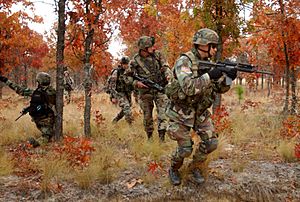Fort Liberty facts for kids
Quick facts for kids Fort Liberty |
|
|---|---|
| Cumberland / Hoke counties (main post), Harnett County (Linden Oaks) near Fayetteville, North Carolina |
|

Barracks of the 1st Brigade, 82nd Airborne Division at Fort Liberty
|
|
| Type | Army base |
| Site information | |
| Controlled by | United States |
| Site history | |
| Built | 1918 |
| In use | 1918–present |
| Garrison information | |
| Current commander |
Colonel K. "Chad" Mixon |
| Country | United States |
| State | North Carolina |
| County | Cumberland |
| Area | |
| • Total | 251.0 sq mi (650.2 km2) |
| • Land | 249.7 sq mi (646.8 km2) |
| • Water | 1.3 sq mi (3.4 km2) |
| Population
(2010)
|
|
| • Total | 39,457 |
| • Density | 158.02/sq mi (61.01/km2) |
| Time zone | UTC−5 (Eastern (EST)) |
| • Summer (DST) | UTC−4 (EDT) |
| ZIP Codes |
28307, 28310
|
| Area codes | 910, 472 |
| FIPS code | 37-24260 |
Fort Liberty, once known as Fort Bragg, is a huge military installation for the United States Army in North Carolina. It's one of the biggest military bases on Earth, with more than 52,000 soldiers! This large base covers parts of Cumberland and Hoke counties. It's also close to the cities of Fayetteville, Spring Lake, and Southern Pines.
Fort Liberty is really big, covering over 251 square miles (650 square kilometers). It's home to the Army's XVIII Airborne Corps and the main office for the United States Army Special Operations Command. This command oversees special forces like the U.S. Army 1st Special Forces Command (Airborne) and the 75th Ranger Regiment.
The base also hosts the famous 82nd Airborne Division, the U.S. Army Forces Command, and the U.S. Army Reserve Command. Fort Liberty has two airfields: Pope Field, used by the United States Air Force for global airlift and special operations, and Simmons Army Airfield, which supports Army aviation units.
Contents
History of Fort Liberty

Starting as Camp Bragg in World War I
Fort Liberty began as Camp Bragg in 1918. It was created as a training area for artillery soldiers. General William J. Snow chose this spot because it had good land, enough water, train access, and a climate that allowed training all year.
The camp was named after Braxton Bragg, who was an artillery commander in the U.S. Army. He later fought for the Confederacy during the American Civil War. The goal was to have six artillery brigades here. Millions of dollars were spent on the land and buildings.
An airfield at the camp was used by planes and balloons to help spot targets for artillery. This airfield was named Pope Field in 1919, honoring First Lieutenant Harley H. Pope, an airman who died in a nearby flight. The camp was finished by November 1919.
After World War I ended, the original plan for six brigades changed. Soldiers and equipment from Camp McClellan, Alabama, moved to Camp Bragg. They began testing new long-range weapons developed during the war. The camp was almost closed in 1921 due to budget cuts. However, the commander, Brig. Gen. Albert J. Bowley, worked hard to keep it open. His efforts paid off, and the closing order was canceled.
On September 30, 1922, Camp Bragg became a permanent Army post and was renamed Fort Bragg. New buildings, including four barracks, were built between 1923 and 1924.
Fort Bragg During World War II
By 1940, the year after World War II began, Fort Bragg had 5,400 people. The next year, it grew to 67,000! Many different Army units trained here during World War II. These included the 9th Infantry Division, the 2nd Armored Division, and the 82nd Airborne Division. At its busiest during the war, Fort Bragg had 159,000 people.
The Cold War Era
After World War II, the 82nd Airborne Division stayed at Fort Bragg permanently. In 1951, the XVIII Airborne Corps was brought back to life here. Fort Bragg became a key place for special warfare. The Psychological Warfare Center opened in 1952, followed by the 10th Special Forces Group.
In 1961, the 5th Special Forces Group was created at Fort Bragg. Their job was to train forces for special missions in Southeast Asia. Also in 1961, the "Iron Mike" statue was dedicated. This statue honors all Airborne soldiers. From 1966 to 1970, over 200,000 young men received basic combat training here. During the Vietnam War in 1968, Fort Bragg's military population reached 57,840.
In the 1980s, units from Fort Bragg were sent to places like Grenada in 1983, Honduras in 1988, and Panama in 1989.
Modernizing for Middle East Wars
In 1990, the XVIII Airborne Corps and the 82nd Airborne Division went to Saudi Arabia. They supported Operation Desert Shield and Operation Desert Storm. In the mid-1990s, Fort Bragg got many new and improved facilities. Old wooden barracks from World War II were replaced. A new main shopping area for soldiers was built, and a new elementary school opened.
Because of the wars in Afghanistan and Iraq, units at Fort Liberty became very busy. Soldiers deployed to combat zones multiple times. In 2011, the U.S. Army Forces Command and U.S. Army Reserve Command moved to Fort Bragg from Georgia. Also, Pope Field officially became part of Fort Bragg in 2011.
Renaming to Fort Liberty
In 2021, a new law was passed to rename military places that were named after Confederate leaders. A special group called The Naming Commission was formed to suggest new names. In 2022, they suggested renaming Fort Bragg, which was named after Confederate General Braxton Bragg, to Fort Liberty.
The Secretary of Defense, Lloyd J. Austin, approved this change. He said the new names would inspire service members and honor American heroes. Fort Liberty is special because it's the only base not named after a specific person. Instead, it represents the value of liberty.
The name change cost about $6.3 million, making it the most expensive renaming project. On June 2, 2023, Fort Liberty officially adopted its new name in a public ceremony.
Units Stationed at Fort Liberty
   |
   |
   |
   |
   |
   |
   |
   |
Fort Liberty is home to many important military units. The main commands are the United States Army Forces Command, the United States Army Reserve Command, and the United States Army Special Operations Command.
Many airborne and special operations units are here. These include the 82nd Airborne Division, the 3rd Special Forces Group (Airborne), and the Delta Force. The Delta Force is controlled by the Joint Special Operations Command, which is also based at Pope Field within Fort Liberty.
Some of the key units include:
- XVIII Airborne Corps: This corps includes its headquarters, the 82nd Airborne Division, and various support brigades like field artillery, engineers, military police, and medical units.
- United States Army Special Operations Command: This command includes the 1st Special Forces Command (Airborne) (with groups like the 3rd Special Forces Group), Psychological Operations Groups, Civil Affairs Brigades, and the John F. Kennedy Special Warfare Center and School.
- Other Army units: These include the United States Army Reserve Command, the United States Army Civil Affairs and Psychological Operations Command, and units for testing and air defense.
- Units at Simmons Army Airfield: The 82nd Aviation Regiment is based here.
- Units at Pope Field: This includes various Air Force support groups and special tactics squadrons. The Joint Special Operations Command, with units like the Delta Force, is also here.
Geography and Nature at Fort Liberty
Fort Liberty is located at 35°8'21" north, 78°59'57" west. The base covers about 49.2 square kilometers (19 square miles). Most of this area is land, with a small amount of water.
The base has many lakes, like Kiest, Simmons, and McFayden lakes. These lakes are carefully managed to keep fish populations healthy. Other lakes, like Croatan and Quail, are also managed. A large floating solar power plant was built on Big Muddy lake.
Fort Liberty is the only place in the world where the endangered Saint Francis' satyr butterfly lives. This special butterfly lives in wet areas with grasses and sedges, often near old beaver dams or streams.
In 1990, the endangered red-cockaded woodpecker became protected. Many of these birds lived at Fort Liberty. This caused some problems for military training. Training had to stop, and some areas were closed.
However, the Army and conservationists found a way to work together. They agreed on rules for training near the woodpeckers' homes. White stripes were painted on trees to show where the birds lived. Training was limited within 200 feet of these areas. Today, the number of woodpeckers has more than doubled. Many training restrictions have been lifted, showing how nature and military needs can coexist.
People and Life at Fort Liberty
Fort Liberty is like a small city. In 2000, about 29,183 people lived on the base. Most households had children living with them, and many were married couples. The average household had about 3.72 people.
The population on base is very diverse. In 2000, about 58.1% were European American, 25.3% African-American, and 15.8% were Hispanic or Latino. The median age was 22 years old. These numbers are typical for military bases, which have many young service members and their families.
Education for Military Families
Children of military staff at Fort Liberty attend schools run by the Department of Defense Education Activity (DoDEA) for kindergarten through eighth grade. There are several elementary and middle schools on base, such as Albritton Middle School and Devers Elementary School.
For high school, students attend local public schools. This depends on which county they live in. Students in Cumberland County parts of the base go to EE Smith High School. Those in the Linden Oaks area, which is in Harnett County, attend Overhills High School.
Memorable Events at Fort Liberty
Fort Liberty has been the site of many important and interesting events over the years:
- In January 1942, actor Mickey Rooney visited Fort Bragg to entertain the soldiers. He was later drafted into the Army himself.
- On October 12, 1961, President John F. Kennedy visited Fort Bragg. He officially approved the wearing of the Green Beret by Special Forces soldiers.
- On May 10, 1987, President Ronald Reagan visited the base during a USO show. Bob Hope and other celebrities were also there.
- On July 1, 1987, a C-130 plane crashed during a public demonstration. Four airmen and one soldier died.
- On March 23, 1994, a tragic accident known as the Green Ramp disaster occurred. Twenty-four soldiers from the 82nd Airborne Division were killed and over 100 injured during a training operation at nearby Pope Air Force base. This was the worst peacetime loss for the division since World War II.
- On June 28, 2005, President George W. Bush gave a nationally televised speech at Fort Bragg. He spoke about the United States' mission in Iraq.
- On December 13, 2011, WWE hosted its annual Tribute to the Troops event at the Crown Coliseum in Fayetteville. Special guests included Robin Williams and Mary J. Blige.
- On December 14, 2011, President Barack Obama gave a nationally televised speech. He thanked soldiers for their service in Operation Iraqi Freedom.
- On July 3, 2016, Fort Bragg hosted a special Major League Baseball game. The Atlanta Braves and Miami Marlins played at a newly built stadium on the base. This was the first time an active military base hosted a regular-season professional sports game. The stadium was built on an old golf course and held 12,500 fans. After the game, the stadium was removed, and the field became a multi-use sports ground.
- On June 2, 2023, Fort Liberty officially adopted its new name in a public ceremony.
Notable People from Fort Liberty
Many interesting people have connections to Fort Liberty:
- Raymond Floyd (born 1942), a professional golfer and member of the World Golf Hall of Fame.
- Chris Hanburger (born 1941), a former NFL linebacker and member of the Pro Football Hall of Fame.
- Patricia Horoho (born 1960), a retired U.S. Army lieutenant general.
- Julianne Moore (born 1960), a famous actress.
- Joe Morris (born 1960), a former NFL running back and Super Bowl champion.
- Passion Richardson (born 1975), an Olympic track and field athlete.
- Hugh Shelton (born 1942), a retired United States Army General and former commander of Fort Liberty (when it was Fort Bragg).
Burials at Fort Liberty
Actress Martha Raye is buried at Fort Liberty. She is honored there for her work with the USO during World War II and the Vietnam War, entertaining soldiers.
Images for kids
See also
 In Spanish: Fuerte Bragg para niños
In Spanish: Fuerte Bragg para niños













